#Philip II Augustus
Explore tagged Tumblr posts
Text


Agnès of Meran and Ingeborg of Denmark
#philip ii augustus#philip augustus#12th century#medieval#agnes of meran#ingeborg of denmark#my art#doodles
28 notes
·
View notes
Text
Matilda, Dame of Bourbon
Coat of Arms of Mathilde, Lady of Bourbon (Image credit: Odejea, Biplanjaune, and Thom.lanaud from Wikimedia Commons) Matilda (or Mahaut or Marguerite) was born c. 1165, the only child of her parents, Archambaud of Bourbon and Alix of Burgundy. Her father stood to inherit the patrimony of Bourbon from his father Archambaud VII but unfortunately, he died in 1169 before acquiring the lordship. As…
#Archambaud VII#Dame de Bourbon#Dame of Bourbon#French history#Gaucher IV of Macon#Guacher IV of Vienne#Guy III of Dampier#King of France#Lord of Bourbon#Lord of Salins#Marguerite of Vienne#Medieval History#Philip II Augustus#Third Crusade#Women’s history
1 note
·
View note
Text
Philippe Auguste
The Capetian monarchy was an institution, with traditions and restrictions. But the personal element in the medieval period always remained a significant factor. To what extent the government of any individual king was personal is not easy to determine. In general it is true that counsellors could advise, but could not normally decide policy. Others were there to obey the will of the monarch, perhaps to help form it, but not to take over from it. Philip's views were shaped by many influences: by observing his father's work, by his father's advice, by his own education, by the advice he received from counsellors, by the experience of governing, by the views of churchmen, theologians, popes and fellow rulers, but in the end they were his views and could be imposed to the extent of the power of the monarchy at the time. Philip's court and government reflected his own personality. Gerald of Wales pointed out its contrasts with the Plantagenet court, the French king's being more sober as we have seen, more quiet in tone, more proper, with swearing forbidden. Philip brought about significant changes: less reliance on the magnates, a lesser role for his family; a greater place for the selected dose counsellors and for relatively humble knights.
It has been suggested that Philip's intellectual gifts were 'modest', which, although direct evidence is not easily available, seems to conflict with what we know about the king's abilities. He was able to deal with the bright men around him, such as Peter the Chanter. He was able to supervise governmental development and the administration, which needed a considerable grasp of accounting as well as a degree of literacy. His ability to deal with the papacy reveals a clear understanding of legal argument and his rights, and a firm determination to protect them. He was rarely outmanoeuvred by even the cleverest of his opponents. Philip went to war as any leader of his period would, but he was more prepared than most to seek and make peace.
Rigord said that Philip's aim was 'to deliver the weak from the tyranny of the strong', and that 'his first triumph is to see peace re-established'. His tolerance and mild temper puzzled the aggressive Bertran de Born, who thought the French needed a leader and had not found one in Philip, who did not become angry. Bertran preferred the attitude of Richard the Lionheart, for whom 'peace and truce have never been noble'. For Bertran it was a sneer to suggest that Philip liked peace even more than the noted diplomat Archbishop Peter of Tarentais. Bertran had cause to regret his underestimation of Philip, when the king later used his authority to replace Bertran as lord of Hautefort. No doubt that act was executed on the advice of counsellors, and Bertran could further nurse his belief that Philip was 'badly advised and worse guided'.
Philip did in fact at times lose his temper, but usually with some point, as when he chopped down the elm on the Norman border, declaring by actions rather than words that he no longer accepted the Plantagenet stance on their rights to bring the king to the edge of their territories before they would hold discussions. Nor were his diplomatic activities always appreciated by his enemies. He could manoeuvre and manipulate with the best of them; he was the 'sower of discord' according to one English chronicler. To take just one example of his methods: in the conquest of Normandy he knew that Rouen was the key, which afterwards he would need to govern. Therefore he did not simply crush Rouen, and chose to discuss with the leading citizens what they would gain from surrender. If allowed in, he promised: 'I will prove a kind and just master to you.' In modern times he has been called 'a statesman of the first water', 'the first royal statesman in French history' ; it is a reputation which in this country we have somehow failed to recognize.
[..]
Philip was generally modest and unassuming, as we have seen in contrast to Richard the Lionheart both in Sicily and in the Holy Land. Bertran de Born thought the French king presented his deeds in tin-plate rather than in gilt. But Philip was aware of the need to present a regal figure, dignified if not flamboyant: a public face of modesty but a recognition of his own powers. The scene painted by Mouskes of Philip entering a church and praying: 'I am but a man, as you are, but I am king of France', has a deep truth to it. There is also a story of Peter the Chanter telling Philip what were the attributes of an ideal sovereign; Philip replied that he should be contented with the king that he had.
The efforts to show his connection back to Charlemagne demonstrate Philip's effort to bolster the Capetian position. His mother, Adela, and his first wife, Isabella of Hainault, both claimed descent from Charlemagne. His natural son was named Peter Charlot, after the great emperor. And the Carolingian claim seems to have become generally accepted. Innocent III declared: 'it is common knowledge that the king of France is descended from the lineage of Charlemagne'. No doubt there was some weakness in the argument, but William the Breton refers to him as 'the descendant of Charlemagne', and the Welshman Gerald believed that Philip aimed to restore the monarchy to 'the greatness which it had in the time of Charlemagne'.
Philip wished to present an imperial image of French monarchy, hence the use of an eagle on his seal, the label 'Augustus' applied by Rigord, his sister's marriage to two Byzantine emperors, and the raising to the Latin imperial throne of two of his brothers-in-law. The same point was being emphasized when the sword of Charlemagne had been brandished at Philip' s coronation ceremony. As one of the Parisian masters wrote in 1210: 'the king is emperor in his realm'. The royal family was being distanced from other families, however noble; royal power was being set above noble power. It was not just a question of wealth and lands, but of the nature of monarchy, its prestige, its religious and mystical significance. The claimed association with Charlemagne, by the twelfth century a powerful figure in legend as well as a great historical emperor, was an important part of this process.
Philip was a tough-minded individual, he would not otherwise have been such a great king. Those who had experience of dealings with Louis VII found Philip a much harder opponent with more steel in his character. He had tremendous determination, and strong views on basic policies. Before his father's death, while still a teenager, Philip was prepared to rule, issuing charters without his father's consent, reacting against some of his father's policies. Before long he threw off the shackles of his mother and her powerful family, and soon afterwards of the count of Flanders. The English chronicler Howden thought he did it because he 'despised and hated all whom he knew to be familiar friends of his father', which seems a distortion, but at least underlines the point that Philip was of independent mind from the first.
Philip preferred his close counsellors to be lesser men who accepted their subordinate role without question. We may be clear that his policy expressed his own views. There was an encounter at one of the conferences between Philip and King John which occurred between Boutavent and Gaillon, when the two kings were 'face to face for an hour, no one except themselves being within hearing', a brief comment but one which allows a sudden and vivid insight into the personal nature of thirteenth-century diplomacy.
Of course Philip took counsel, and made a point of doing so, but he was too independent a man to be dominated by another. And though inclined to prefer diplomatic solutions, he was a good enough warrior to win respect; as William the Breton said 'his arm was powerful in the use of weapons'. Bouvines was the most important battle of the age, and Philip was the victor. Where the loss of documentary evidence from the earlier period often makes it impossible to be certain that Philip was the innovator or the initiator, a knowledge of his character, his able leadership and his drive, make him far and away the likeliest candidate. One of Philip's major achievements was to shift the balances of an intricate system of government in France in favour of the Capetian monarchy, so that its views were more often heeded, and came to be heeded in areas where that had not previously been the case.
Jim Bradbury- Philip Augustus, King of France, 1180-1223xiii
#xii#xiii#jim bradbury#philip augustus king of france 1180-1223#philippe ii#philippe auguste#pierre le chantre#rigord#bertran de born#richard coeur de lion#adèle de champagne#isabelle de hainaut#agnès de france#jean sans terre#battle of bouvines
6 notes
·
View notes
Note
And Philip & Lilibet!✨❤










💍
💍: which is/was best royal couple part 2
Victoria Princess Royal and Crown Prince Fredrick of Prussia

2. Olga Alexandrovna and Nikolai Kulikovsky
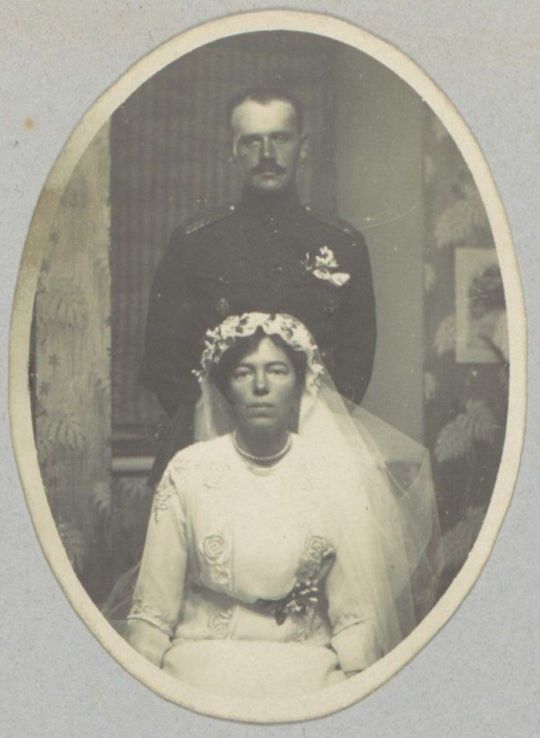
3. Tsar Alexander III and Maria Feodorovna
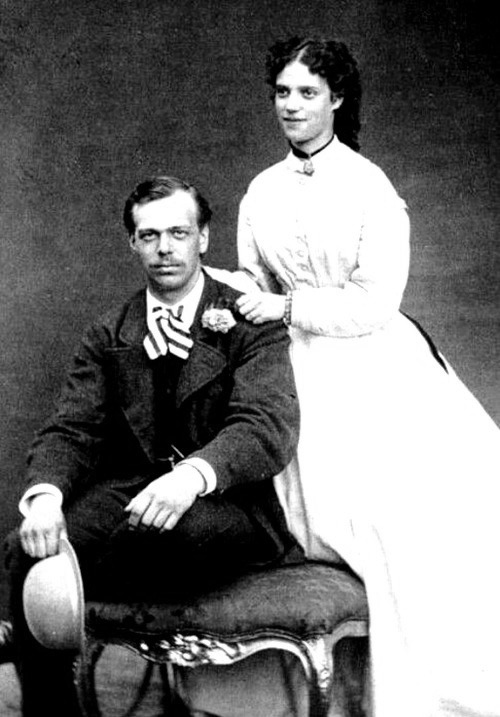
4. Princess Thyra of Denmark and Crown Prince Ernst August of Hanover
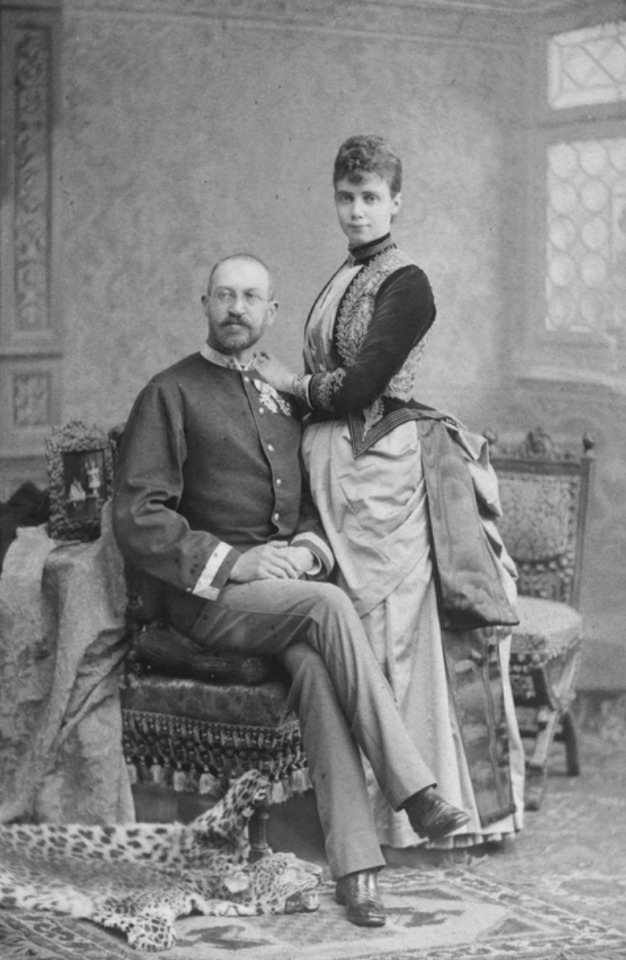
Thank you for asking me questions!!! (Sorry this took an extremely long time to answer)
#victoria princess royal#empress victoria of germany#kaiser frederick iii of germany#grand duchess olga alexandrovna#nikolai kulikovsky#tsar alexander iii#empress maria feodorovna#dagmar of denmark#princess thyra of denmark#crown princess thyra of hanover#crown prince ernest augustus of hanover#prince philip#duke of edinburgh#queen elizabeth ii#elizabeth windsor
34 notes
·
View notes
Text
Alexander the Great in Greek Art
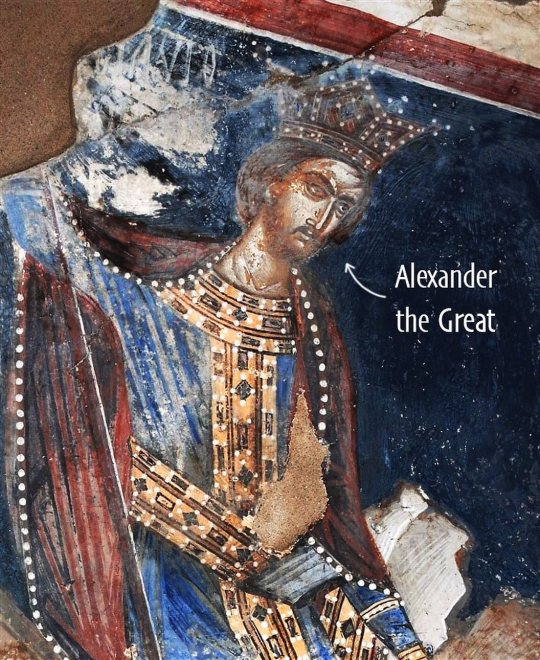
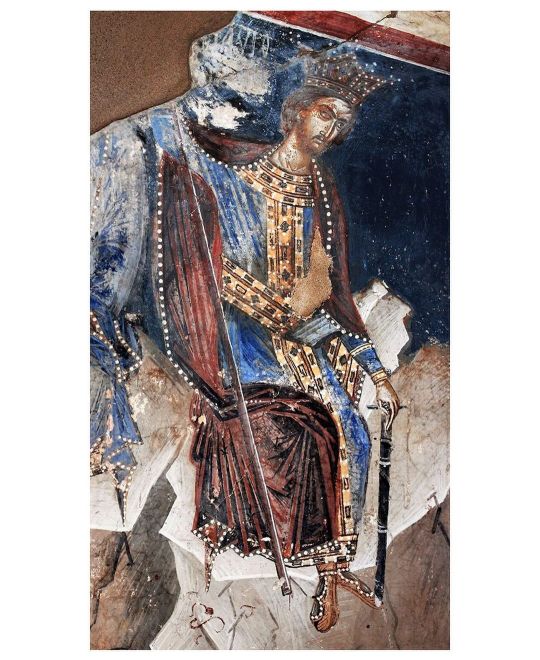
Alexander the Great (as per the official statement of the restorers). At. Demetrius Church, Palatitsia by unknown artist, 1570
Aigai was the original capital of the Macedonian Kingdom and the place where Philip II was killed. Although the capital was later transferred to Pella, Aigai remained the burial place for the Macedonian kings. The little church still maintains part of the ancient history alive as its interior bears incorporated architectural elements from the palace of Philip II. Alexander is depicted as a representative of the “Kingdom of the Greeks” -one of the four kingdoms that predate the end of times according to the prophet Daniel’s interpretation of Nebuchadnezzar II’s eschatological dream. Alexander the Great in Byzantine art:


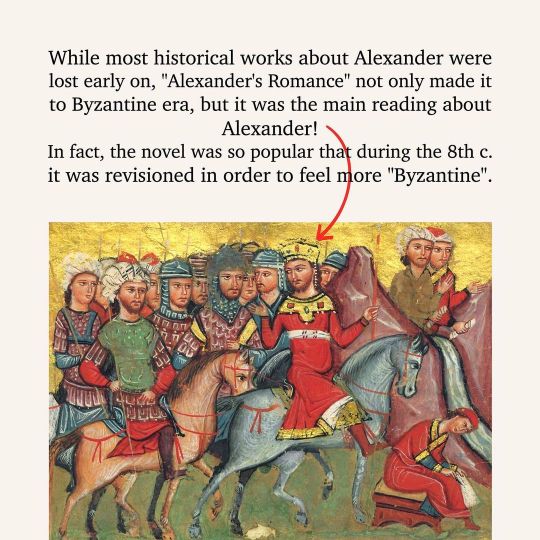


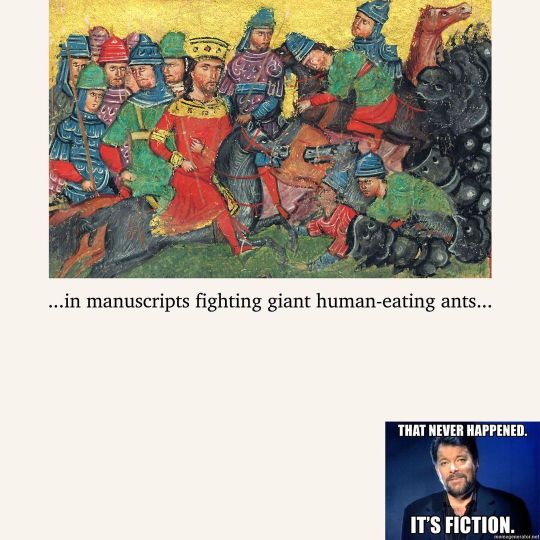
Note, 7th painting because it shows a very important concept in Byzantine understanding of their past: Next to Alexander the "βασιλεύς των Ελλήνων" (emperor/king of the Hellenes/Greeks), you can see Octavian "βασιλεύς των Ρωμαίων" (emperor of the Romans/Byzantines). Alexander and Octavian Augustus were the most important historical rulers of the future Christian Romans (our so-called "Byzantines) before the reign of Constantine the Great.
source1
source2
#Alexander the Great#He's always been “our king” so to speak#greek history#history#hagiography#orthodoxy#Christianity#greek orthodox
77 notes
·
View notes
Text

Kandake, kadake or kentake (Meroitic: 𐦲𐦷𐦲𐦡 kdke), often Latinised as Candace (Ancient Greek: Κανδάκη, Kandakē), was the Meroitic term for the sister of the king of Kush who, due to the matrilineal succession, would bear the next heir, making her a queen mother.

Pliny writes that the "Queen of the Ethiopians" bore the title Candace, and indicates that the Ethiopians had conquered ancient Syria and the Mediterranean.
In 25 BC the Kush kandake Amanirenas, as reported by Strabo, attacked the city of Syene, today's Aswan, in territory of the Roman Empire; Emperor Augustus destroyed the city of Napata in retaliation.
Cassius Dio wrote that Kandake's army advanced as far as the Elephantine in Egypt, but Petronius defeated them and took Napata, their capital, and other cities.
Four African queens were known to the Greco-Roman world as the "Candaces": Amanishakheto, Amanirenas, Nawidemak, and Malegereabar

Biblical usage
The Baptism of Queen Candace's Eunuch (c. 1625–30, attributed to Hendrick van Balen and Jan Brueghel the Younger)
In the New Testament, a treasury official of "Candace, queen of the Ethiopians", returning from a trip to Jerusalem, met with Philip the Evangelist:
Now an angel of the Lord said to Philip, "Rise and go toward the south to the road that goes down from Jerusalem to Gaza." This is a desert place. And he rose and went. And there was an Ethiopian, a eunuch, a court official of Candace, queen of the Ethiopians, who was in charge of all her treasure. He had come to Jerusalem to worship
He discussed with Philip the meaning of a perplexing passage from the Book of Isaiah. Philip explained the scripture to him and he was promptly baptised in some nearby water. The eunuch 'went on his way, rejoicing', and presumably therefore reported back on his conversion to the Kandake

Evidence outside of Nubia that shows additional links to Kushite's queenship concept are found in Ethiopia. Ethiopia has a long dynastic history claimed to be over three millennia from before 1000 BC to 1973, the year of the overthrow of the last Menelik emperor, Haile Selassie. The Ethiopian monarchy's official chronicle of dynastic succession descends from Menelik I includes six regnant queens referred to as Kandake. The following queens from the king list have "Kandake" added to their name:
Nicauta Kandake (r. 740–730 BCE)
Nikawla Kandake II (r. 342–332 BCE)
Akawsis Kandake III (r. 325–315 BCE)
Nikosis Kandake IV (r. 242–232 BCE)
Nicotnis Kandake V (r. 35–25 BCE)
Garsemot Kandake VI (r. 40–50 CE) – Allegedly the queen who ruled at the time of the Biblical story of the Ethiopian eunuch.
Twenty-one queens are recorded as sole regent in the kingdom of Ethiopia until the 9th century CE. The conquest of Meroe by the Axumite King Ezana may well provide the historical fiction for the Ethiopian dynastic claim to the Nubian Kandakes and their kings, as it was from this point onwards that the Axumites began calling themselves "Ethiopians", a Greco-Roman term previously used largely for the ancient Nubians. For example, Makeda, Queen of Sheba, in the Kebra Nagast, is also recognized as Candace or "Queen Mother".

Alexandrian legend
Jewellery of Kandake Amanishakheto, from her tomb
A legend in the Alexander romance claims that "Candace of Meroë" fought Alexander the Great. In fact, Alexander never attacked Nubia and never attempted to move further south than the oasis of Siwa in Egypt. The story is that when Alexander attempted to conquer her lands in 332 BC, she arranged her armies strategically to meet him and was present on a war elephant when he approached. Having assessed the strength of her armies, Alexander decided to withdraw from Nubia, heading to Egypt instead. Another story claims that Alexander and Candace had a romantic encounter.
These accounts originate from Alexander Romance by an unknown writer called Pseudo-Callisthenes, and the work is largely a fictionalized and grandiose account of Alexander's life. It is commonly quoted, but there seems to be no historical reference to this event from Alexander's time. The whole story of Alexander and Candace's encounter appears to be legendary.
John Malalas has mixed the Pseudo-Callisthenes material with other and wrote about the affair of Alexander with Kandake, adding that they got married. Malalas also wrote that Kandake was an Indian queen and Alexander met her during his Indian campaign

List of ruling kandakes
Pyramid of Amanitore in modern day Sudan
See also: List of monarchs of Kush
At least eleven kandakes also ruled in their own right as monarchs (i.e. queen regnants) of Kush:
Nahirqo (middle 2nd century BC)
An unknown queen regnant (end of the 2nd–first half of the 1st century BC)
Amanirenas (end of the 1st century BC–beginning of the 1st century AD)
Amanishakheto (early 1st century AD)
Shanakdakhete (first half of the 1st century AD)
Nawidemak (first half of the 1st century AD?)
Amanitore (middle 1st century AD)
Amanikhatashan (middle 2nd century AD?)
Amanikhalika (second half of the 2nd century AD)
Patrapeamani [de] (early 4th century)
Amanipilade (mid-4th century)
Based on the reading of a single inscription, some lists give two later kandakes named Maloqorebar (266–283 AD) and Lahideamani (306-314 AD). A recently discovered inscription corrects this earlier reading, however, showing that neither was a woman.

Archaeological sources
The Kandakes of Meroe were first described through the Greek geographer's Strabo account of the "one-eyed Candace" in 23 BCE in his encyclopedia Geographica. There are at least ten regnant Meroitic queens during the 500 years between 260 BCE and 320 CE, and at least six during the 140 periods between 60 BC and 80 AD. The iconographic portrayal of the Meroitic queens depicts them as women often alone and at the forefront of their stelae and sculptures and shown in regal women's clothing. Early depictions of Kushite queens typically do not have Egyptian elements making their appearance drastically different from their Kushite men and Egyptian counterparts. As seen in the Dream Stela of Tanawetamani, a large shawl was wrapped around the body with an additionally decorated cloak worn over the first; typically, a small tab-like element hanging below the hem touches the ground and has been interpreted as a little tail. The first association with this element of dress is with Tarharqo's mother during his coronation ceremony.
It was not until George Reisner excavated the royal cemeteries at El Kurru and Nuri that archaeological material became available to study the Kushite queenship. Additionally, a few royal tombs of Kushite women have been found at Meroe's cemetery and in Egypt at Abydos (Leahy 1994). At El Kurru, six pyramids belong to royal women of the 25th Dynasty and a pyramid for queen Qalhata of the Napatan period. At Nuri, the tombs of royal women are located on the west plateau with more inscriptional information available at the site, linking the roles that the kings' mothers played in succession and their importance during the Kushite dynasty.
The most important event that Kushite women participated in was kingship's ensured continuity, where royal women were mentioned and represented in the royal ceremony. The lunettes of the stelae of Tanawetamani, Harsiyotef, and Nastasen all provide iconographic and textual evidence of these kings' enthronement. In all of these stelae, the king is accompanied by a female member of his family, mother, and wife. The king's mother played an essential role in the legitimacy of her son as the king; textual evidence from Taharqo's coronation stelae represents inscriptional evidence suggesting that the king's mother traveled to her son's coronation. During the Kushite 25th Dynasty, the office that is known as God's Wife of Amun was established. The royal women in this role acted as the primary contact with the Kushite god Amun. They played a decisive role in the king's accession to the throne.
Bas-reliefs dated to about 170 B.C. reveal the kentake Shanakdakheto, dressed in armor and wielding a spear in battle. She did not rule as queen regent or queen mother, but as a fully independent ruler. Her husband was her consort. In bas-reliefs found in the ruins of building projects she commissioned, Shanakdakheto is portrayed both alone as well as with her husband and son, who would inherit the throne by her death.

#african#afrakan#kemetic dreams#africans#brownskin#brown skin#afrakans#african culture#afrakan spirituality#ta seti#north africa#kandake#candace#kemet#nile valley#hapi valley#hapi#east africa#north east africa#Napata#african history#africantumblr#Shanakdakheto#Kushite 25th Dynasty#haile selassie#amun#amun ra#amunet#Kebra Nagast#meroe
30 notes
·
View notes
Text

Portrait of Charles of Bourbon
Artist: Jean Ranc (French, 1674–1735)
Title: El infante Carlos de Borbón (Futuro Carlos III de España)
Date: 1725
Medium: Oil on Canvas
Collection: Royal Palace of Madrid, Madrid, Spain
Charles III of Spain
Charles III of Spain ( Madrid , 20 January 1716 – Madrid, 14 December 1788), called " the Politician " or " the Best Mayor of Madrid ", was King of Spain from 1759 until his death in 1788; Duke of Parma and Piacenza ��as Charles I— between 1731 and 1735; and King of Naples —as Charles VII— and of Sicily —as Charles V— between 1734 and 1759.
Carlos was the third son of Philip V to reach adulthood and the first he had with his second wife, Isabel Farnesio , so it was his half-brothers Luis I and Fernando VI who initially succeeded their father. Their death without issue would lead to Carlos occupying the Spanish throne.
Charles served the family policy as a piece in the struggle to regain Spanish influence in Italy: he initially inherited the duchies of Parma and Piacenza from his mother in 1731; but later, when Philip V reconquered the Kingdom of Naples and Sicily in the course of the War of the Polish Succession (1733–38), he became king of those territories under the name of Charles VII. He married in 1738 Maria Amalia of Saxony , daughter of Frederick Augustus II , Duke of Saxony and Lithuania and King of Poland .
#portrait#charles of bourbon#charles iii#spanish king#18th century painting#french painter#european#oil on canvas#spanish culture#history#costume#adolescent#wig
8 notes
·
View notes
Text
"One of the most unequivocal examples of patronage linking the Angevin kings and their mothers is seen in the Cistercian abbey of Notre-Dame en Voeu, Normandy. A charter from 1152 recorded the foundation by [Empress Matilda] and Henry II, and stated that she and her son created the abbey in honour of Henry I, Matilda of Scotland, and Geoffrey of Anjou, as well as for the souls of their heirs. The abbey was created after Matilda made a vow to found a new Cistercian order after the 1142 siege of Oxford. Henry II confirmed Matilda’s foundation of the abbey in a charter dating between 1170 and 1179, and placed Notre-Dame-en-Voeu under his protection in a separate charter issued between 1174 and 1182.
[Eleanor of Aquitaine] also made a grant to Notre-Dame-en-Voeu between 1189 and 1191, consisting of a portion of land from the forest of Lillebonne, part of her dower settlement, though whether this was through her own instigation or Henry’s is unknown. It is plausible she would have supported the abbey as a new site of familial patronage. John also made a grant to the abbey in 1201, which was plausibly at Eleanor’s instigation given the association of the Plantagenets with this institution. This charter, in combination with a separate grant to Bec in 1203, demonstrates the importance of Normandy to John at this critical juncture of war with Philip Augustus. This is of particular significance when contrasted with John’s activities in Normandy prior to becoming king, as highlighted by Nicholas Vincent, wherein John’s patronage of Norman institutions was scarce. Given the attention paid to Fontevraud as a familial mausolea [...] and the expanse of the Angevin dominions, it is not surprising a separate site for Angevin patronage was established with Notre-Dame-en-Voeu. Situated in the Anglo-Norman heartlands, it showed the extension of Plantagenet patronage across its domains. This example of ecclesiastical patronage shows the strength of the mother-son relationships in the Angevin domains, as both Matilda and Eleanor bound their sons to patronise a specific establishment. The motivations for doing so were to ensure dynastic security in these regions and demonstrates the co-operation and familial harmony between the three kings and their mothers."
-Gabrielle Storey, "Co-Rulership, Co-operation and Competition: Queenship in the Angevin Domains, 1135-1230", University of Winchester, PHD thesis, 2020.
#this thesis is available online and is excellent if anyone wants to read it#it has some great stuff on Berengaria of Navarre and Isabella of Angouleme as well <3#empress matilda#henry ii#eleanor of aquitaine#king john#angevins#my post#english history#queue
14 notes
·
View notes
Text
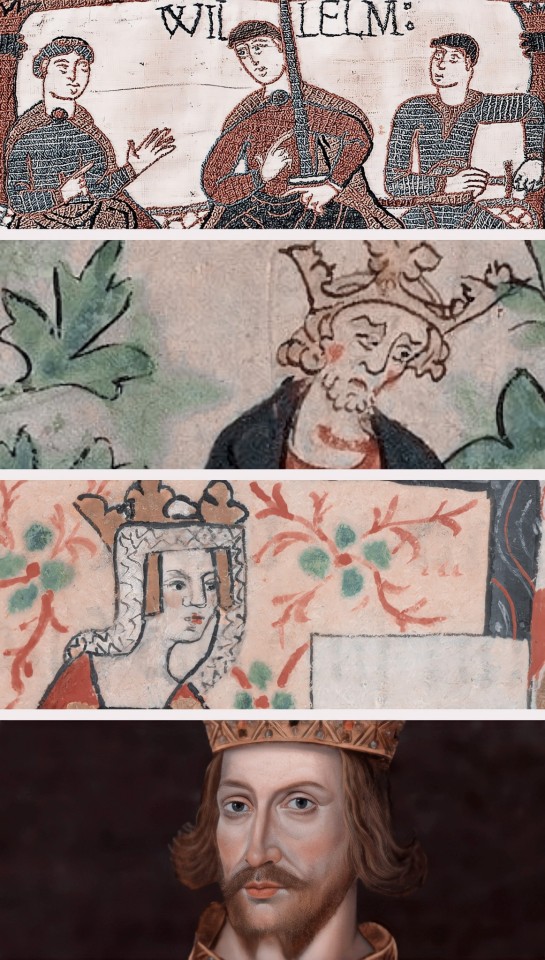



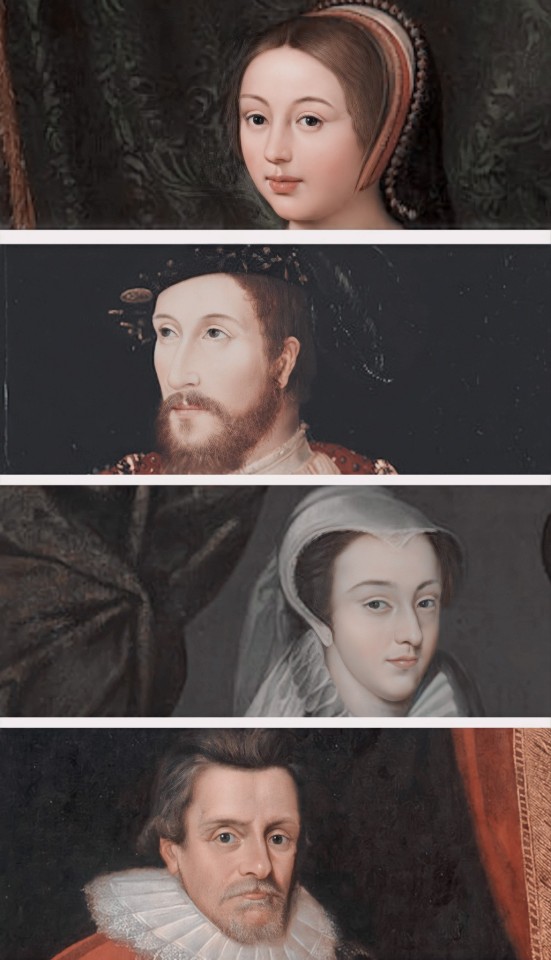

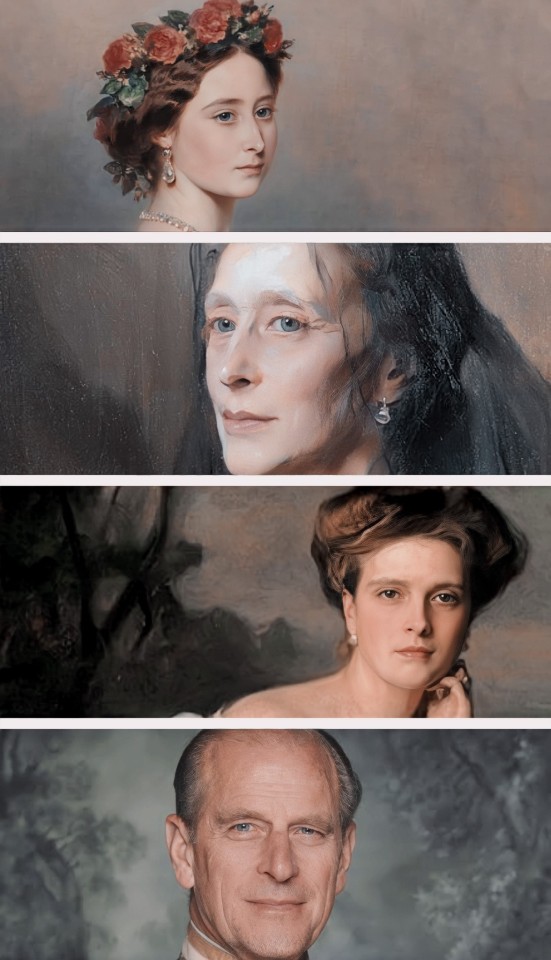

⋆ William, The Conqueror to Prince Louis of Wales ⋆
⤜ William I is Prince Louis of Wales' 25th Great-Grandfather via his paternal line through Prince Philip
William I of England
Henry I of England
Empress Matilda
Henry II of England
John of England
Henry III of England
Edward I of England
Edward II of England
Edward III of England
Lionel of Antwerp, Ist Duke of Clarence
Philippa Plantagenet, Vth Countess of Ulster
Roger Mortimer, IVth Earl of March
Anne Mortimer
Richard Plantagenet, IIIrd Duke of York
Edward IV of England
Elizabeth of York
Margaret Tudor, Queen of Scotland
James V, King of Scotland
Mary Stewart, Queen of Scotland
James I of England
Elizabeth Stuart, Queen of Bohemia
Sophia, Electress of Hanover
George I of Great Britain
George II of Great Britain
Frederick, Prince of Wales
George III of the United Kingdom
Prince Edward Augustus, Duke of Kent and Strathearn
Victoria of the United Kingdom
Princess Alice of the United Kingdom, Grand Duchess of Hesse
Princess Victoria of Hesse and by Rhine
Princess Alice of Battenberg
Prince Philip of Greece and Denmark
King Charles III of the United Kingdom
William, The Prince of Wales
Prince Louis of Wales
#royal line from william i#the british royal line#british royal family#british royals#royalty#royals#brf#british royalty#history#historical royals#house of york#house of tudor#house of plantagenet#royal#medieval ages#william the conqueror#king charles iii#prince william#the prince of wales#prince of wales#queen victoria#mary queen of scots#prince philip#duke of edinburgh#house of stuart#house of stewart#house of windsor#elizabeth of york#prince louis of wales#prince louis
126 notes
·
View notes
Photo
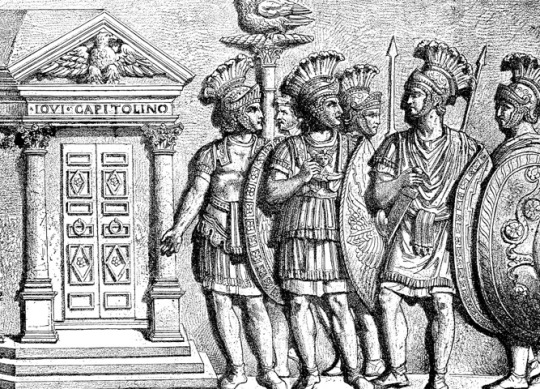
The Rise and Fall of The Praetorian Guard
THE PRAETORIAN GUARD WERE AN ELITE UNIT WITHIN THE IMPERIAL ARMY, SERVING PRIMARILY AS PERSONAL PROTECTORS AND INTELLIGENCE OPERATIVES FOR THE ROMAN EMPERORS.
The roots of the guard can be found during the Roman Republic, when soldiers served as protectors for Roman generals and important figures, or as elite guards for military praetors.
High-ranked generals with imperium held public office by serving as a magistrate or promagistrate. They were assigned a civil servant, lictors, to serve as an attendant and bodyguard. Where no personal bodyguard was assigned, senior field officers safeguarded themselves with temporary bodyguard units of selected soldiers.
Around 40 BC, Octavian, who would later become Emperor Caesar Augustus, installed praetorians within the pomerium (a religious boundary around the city of Rome), the first example of troops being permanently garrisoned in Rome proper.
Members of the guard accompanied Augustus on active campaigns, protecting the civic administrations and rule of law. At camp, the cohors praetoria (a cohort of praetorians guarding the commander), were posted near the praetorium, the tent of the commander, which the guard is believed to be named after.
After the construction of Rome’s Praetorian camp known as the Castra Praetoria around 23 BC, their role extended to escorting the emperor and the members of the imperial family, and to serve as a policing force during times of riot.
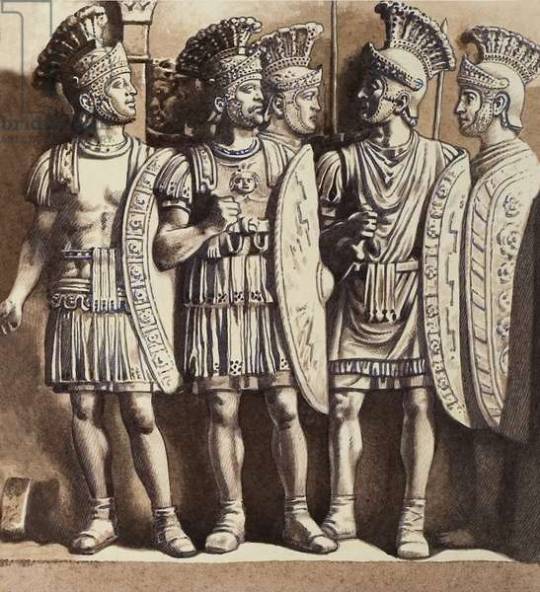
According to the Roman historian and politician, Tacitus, the guard around this time numbered nine Praetorian cohorts (4500 men, the equivalent of a legion), however, an inscription from near the end of Augustus’s rule suggests that their numbers were briefly increased to twelve.
The Praetorian Guard, like all legionaries, shared similar insignia, mainly on their shields. Praetorian Guard shields included wings and thunderbolts, referring to Jupiter, and also uniquely included scorpions, stars and crescents.
The first military engagement of the Praetorian Guard took place during the mutinies of Pannonia and the mutinies of Germania. Drusus Julius Caesar, son of Tiberius, accompanied by two Praetorian cohorts, the Praetorian Cavalry, and Imperial German Bodyguards, suppressed the mutinies of Pannonia. Germanicus, later known as Germanicus Julius Caesar, led a force of legions and detachments of the Praetorian Guard in a two-year campaign in Germania against the uprising.

In the three centuries that followed, the guard influenced imperial politics by overthrowing emperors and proclaiming the successor. Members of the guard were also directly involved in the assassination of emperors, such as: Aurelian, Balbinus, Caligula, Caracalla, Commodus, Elagabalus, Galba, Pupienus, Pertinax, Philip II, and Probus.
In AD 305, Diocletian and Maximian abdicated, and the former Caesares, Constantius and Galerius became Augusti. Although two sons of emperors, Constantine I and Maxentius were eligible, they were passed over for a new tetrarchy, and Valerius Severus and Maximinus Daza were appointed Caesars.
Severus planned to disband the Praetorian Guard on the orders of Galerius, resulting in the guard giving their allegiance to Maxentius and proclaiming him emperor. By AD 312, Constantine I marched on Rome with a force of 40,000 soldiers to eliminate Maxentius, facing off against an army that encompassed the bulk of the Praetorian Guard garrisoned in Rome at the Battle of the Milvian Bridge on the River Tiber.

Contemporary accounts record Maxentius’s forces being pushed back against the river and retreating across the bridge. The weight of soldiers fleeing caused the bridge to collapse, stranding elements of the guard on the northern bank of the river who were either killed or taken prisoner.
Lucius Caecilius Firmianus, a Christian author and advisor to Constantine recorded the events: “The bridge in his rear was broken down. At sight of that the battle grew hotter. The hand of the Lord prevailed, and the forces of Maxentius were routed. He fled towards the broken bridge; but the multitude pressing on him, he was driven headlong into the Tiber [drowned].”
Maxentius’ body was fished out of the Tiber and decapitated, and his head was paraded through the streets of Rome. Supporters of Maxentius were eliminated and the Praetorian Guard and Imperial Horse Guard were disbanded. The remaining guard were sent in exile to the corners of the empire, and the Castra Praetoria was dismantled in a grand gesture that marked the end of the Praetorians.
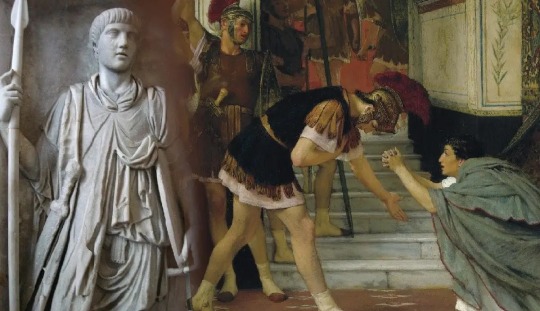
#The Rise and Fall of The Praetorian Guard#The Imperial Army#The Imperial Guard#The Roman Legion#history#history news#ancient history#ancient culture#ancient civilizations#ancient rome#roman history#roman empire#roman emperor#long post#long reads
83 notes
·
View notes
Text



Thomas Stafford was the ninth child and second surviving son of Henry Stafford, 1st Baron Stafford and Ursula Pole. Little is known of his early life, first being mentioned in 1550 as he travelled to Rome, where he associated with his uncle Reginald Cardinal Pole. He spent three years in Italy before travelling to Poland, obtaining the recommendation of King Sigismund Augustus who requested Mary restore him to the Dukedom of Buckingham. Augustus's appeal appeared to have no effect. When Stafford returned to England in January 1554 he joined the rebellion led by Thomas Wyatt; this arose out of concern of Mary's determination to marry Philip II of Spain. The rebellion failed and Thomas was captured and briefly imprisoned in the Fleet Prison before fleeing to France. There, he intrigued with other English exiles and continued to promote his claim to the English throne. On 18 April 1557 (Easter Sunday) Stafford sailed from Dieppe with two ships and over 30 men. Landing in Scarborough on 25 April 1557, he walked into the unprotected castle and proclaimed himself Protector of the Realm,[2] attempting to incite a new revolt by denouncing the Spanish marriage, railed against increased Spanish influence and promised to return the crown "to the trewe Inglyshe bloude of our owne naterall countrye".[1][3][4] Stafford claimed he had seen letters at Dieppe showing that Scarborough and 12 other castles would be given to Philip II and garrisoned with 12,000 Spanish soldiers before his coronation.[5] Three days later, the Earl of Westmorland recaptured the castle and arrested Stafford and his companions. Stafford was beheaded for treason on 28 May 1557 on Tower Hill, after imprisonment in the Tower of London. Thirty-two of his followers were also executed after the rebellion.[6].
#rlly showcasing hcavill's 'acting' here...anyways. let me mind my business#i need the tudors to be less underrated than it is bcus like. the way i totally buy this was a rant he totally gave...#'they have plantagenet blood in their veins' (so do you; babygirl) and all#bcs like. he is truly the worst. but is he wrong?#thomas stafford like my grandfather was right! the tudors suck dhfagrfwragfm#honestly the reason being given as her marriage to felipe ii was probably just a pretense#also yes this is all from wiki. don't judge me .#for all the faults of the writing (and it had plenty) it really like...took you to that emotional place#of this is the worst man in the world but also. he's sort of right. and just lets you sit#in the discomfort of that...#and also that this is all his self-fulfilling prophecy to some extent. reginald pole wrote that indictment of him#but he didn't have it widely published until he. yk. killed his entire fucking family bar geoffrey#(and then this does happen to edward courtenany to some extent too. altho it seems he was more pawned than complicit)#marian#henrician#i actually didn't know about this rebellion ...really contradicts that narrative#that all mary's plantagent relatives 'adored' her; huh?
10 notes
·
View notes
Text

Witchcraft
#philip ii augustus#Philip Augustus#Philip II of France#Medieval#12th century#Pope innocent III#commistio sexuum#Lmao#doodles
6 notes
·
View notes
Text
Events 7.12 (before 1920)
70 – The armies of Titus attack the walls of Jerusalem after a six-month siege. Three days later they breach the walls, which enables the army to destroy the Second Temple. 927 – King Constantine II of Scotland, King Hywel Dda of Deheubarth, Ealdred of Bamburgh and King Owain of the Cumbrians accepted the overlordship of King Æthelstan of England, leading to seven years of peace in the north. 1191 – Third Crusade: Saladin's garrison surrenders to Philip Augustus, ending the two-year siege of Acre. 1335 – Pope Benedict XII issues the papal bull Fulgens sicut stella matutina to reform the Cistercian Order. 1470 – The Ottomans capture Euboea. 1488 – Joseon Dynasty official Choe Bu returned to Korea after months of shipwrecked travel in China. 1493 – Hartmann Schedel's Nuremberg Chronicle, one of the best-documented early printed books, is published. 1527 – Lê Cung Hoàng ceded the throne to Mạc Đăng Dung, ending the Lê dynasty and starting the Mạc dynasty. 1543 – King Henry VIII of England marries his sixth and last wife, Catherine Parr, at Hampton Court Palace. 1562 – Fray Diego de Landa, acting Bishop of Yucatán, burns the sacred idols and books of the Maya. 1576 – Mughal Empire annexes Bengal after defeating the Bengal Sultanate at the Battle of Rajmahal. 1580 – The Ostrog Bible, one of the early printed Bibles in a Slavic language, is published. 1691 – Battle of Aughrim (Julian calendar): The decisive victory of William III of England's forces in Ireland. 1776 – Captain James Cook begins his third voyage. 1789 – In response to the dismissal of the French finance minister Jacques Necker, the radical journalist Camille Desmoulins gives a speech which results in the storming of the Bastille two days later. 1790 – The Civil Constitution of the Clergy is passed in France by the National Constituent Assembly. 1799 – Ranjit Singh conquers Lahore and becomes Maharaja of the Punjab (Sikh Empire). 1801 – British ships inflict heavy damage on Spanish and French ships in the Second Battle of Algeciras. 1806 – At the insistence of Napoleon, Bavaria, Baden, Württemberg and thirteen minor principalities leave the Holy Roman Empire and form the Confederation of the Rhine. 1812 – The American Army of the Northwest briefly occupies the Upper Canadian settlement at what is now at Windsor, Ontario. 1862 – The Medal of Honor is authorized by the United States Congress. 1913 – Serbian forces begin their siege of the Bulgarian city of Vidin; the siege is later called off when the war ends. 1913 – The Second Revolution breaks out against the Beiyang government, as Li Liejun proclaims Jiangxi independent from the Republic of China. 1917 – The Bisbee Deportation occurs as vigilantes kidnap and deport nearly 1,300 striking miners and others from Bisbee, Arizona. 1918 – The Imperial Japanese Navy battleship Kawachi blows up at Shunan, western Honshu, Japan, killing at least 621.
2 notes
·
View notes
Text
The year in which Normandy collapsed
The year 1204 cannot quite claim to be the annus mirabilis of Philip Augustus- that must be reserved for his triumphs of 1214- but the year in which Normandy collapsed must run it close. With the fall of Château-Gaillard, Plantagenet Normandy fell apart. Town after town, castle after castle surrendered. As with Les Andelys, so with Rouen, Philip worked his way around the target, gradually isolating it. The capital had always been his eventual target in the duchy. He first aimed against southern Normandy, moving along the River Risle. He thus foiled John's attempt to defend the River Touques, and then moved on to te valley of the Orne, making what has been called "a brilliant left-hook."
In three weeks during May Philip took Argentan and Falaise, and reaching the Normandy coast near St. Pierre-sur-Dives. Lupescar, who commanded the supposedly impregnable Falaise, surrendered within a week, and went over to Philip. Like Geoffrey of Anjou before him, Philip captured the central block of the duchy before closing in for the kill at Rouen. Domfront, Caen, Bayeux and Lisieux fell into his hands as western Normandy collapsed. Caen, standing amidst fertile fields and meadows, offered no resistance at all. It did not possess enough in the treasury to pay for its own defence, and the Plantagenet archives for the duchy were smuggled away to England. In the far west of Normandy, Philip's Breton allies under Guy de Thouars took both Mont-Saint-Michel and Avranches, then joined the French king at Caen.
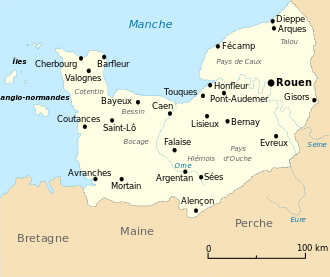
Now only Arques and Rouen in the east offered resistance in Normandy. Rouen, the major objective, was protected by double walls and triple ditches, but by now morale was low and isolation increasing. Having gained control of most of the surrounding area, the French closed in. Philip captured the barbican at the head of the bridge, and the citizens of Rouen themselves destroyed four arches of the bridge in a vain effort to prevent the French from crossing.
Philip had arrived at Rouen in May of 1204. On 1 June the Norman capital, under John's "trusty and well-beloved" Peter des Préaux, agreed to yield to Philip if no aid was received within thirty days. The city was given no hope from John and surrendered on 24 June, even before the time of the agreement was up. Normandy's fate was settled, the whole duchy was in the hands of the Capetian king, which in the words of William the Breton, "was something one had never thought possible in any circumstances."
How far John was responsible for the loss of Normandy and much of the continental Plantagenet Empire has been a matter of some debate. Warren has defended John, while Gillingham has blamed him, suggesting that so long as the Lionheart was alive the Angevin Empire was in good health.
Obviously there were various factors at play in the fall of the duchy, and there is no single explanation, which means that all the blame cannot be placed upon John. Professor Bates has seen the 'fall' of Normandy, from an independent principality, as a more gradual process. He has suggested, at least by implication, that the duchy only 'rose' and was powerful when the French monarchy was weak. The practice of Norman magnates in going over to the enemies of the dukes was not a new phenomenon and cannot alone be the explanation of John's failure; problems for the dukes from families based in the border areas had never been absent. Yet the suspicion remains that things were badly managed by John and made worse than they otherwise would have been.
The Angevin Empire had never broken out of the framework of being, with regard to its continent possessions, always in some way under the lordship of the kings of France. The absorption of Normandy into a larger political entity in both the 'Norman Empire' of the Conqueror and his immediate successors, and into the Angevin Empire of Henry II and his sons, meant that the duke was no longer able to concentrate solely on ruling Normandy. His presence was less, his interests often elsewhere. Through most of the twelfth century the duke was in no sense even a Norman. It is not surprising if loyalty to an increasingly remote ruler had waned through that period.
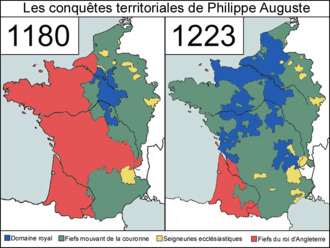
King John's aged mother, Eleanor of Aquitaine, who had done what she could to prop up his position, died on 1 April 1204. This seriously weakened his hold on the duchy of Aquitaine. Men from the south, who had come to respect the often-present Richard, and who had remained loyal while Eleanor was still alive, were without the same sense of duty to her younger son, and now rushed to do homage to Philip. The collapse of the southern Angevin Empire in 1204 was as much a voluntary surrender as a conquest.
Jim Bradbury- Philip Augustus, King of France, 1180-1223
#xiii#jim bradbury#philip augustus king of france 1180 1223#the fall of the plantagenet empire#capetians vs plantagenets#philippe ii#philippe auguste
5 notes
·
View notes
Text
List of Roman Emperors and how many future emperors were born during their reign
"?" is for emperors whose birthdate is unclear, they'd be listed under every possible option
Emperors with no known birthdate won't be counted towards any reign
A lot of the reigns overlap (especially after the Empire is divided between east and west) so some emperors are born during the reign of several previous emperors
Republican Era: 2. Augustus, Tiberius
Agustus (40 years): 5. Caligula, Claudius, Galba, Vitellius, Vespasian
Tiberius (22 years): 2. Otho, Nerva
Caligula (4 years): 2. Nero, Titus
Claudius (14 years): 2. Domitian, Trajan
Nero (14 years): 0.
Galba (7 months): 0.
Otho (3 months): 0.
Vitellius (8 months): 0.
Vespasian (10 years): 1. Hadrian
Titus (2 years): 0.
Domitian (15 years): 1. Antoninus Pius
Nerva (1 year): 0.
Trajan (20 years): 0.
Hadrian (21 years): 4. Marcus Aurelius, Lucius Verus, Pertinax, Didius Julianus
Antoninus Pius (23 years): 2. Septimius Severus, Gordian I
Marcus Aurelius (19 years): 3-4. Commodus, Macrinus, Maximunus Thrax?, Pupienus
Lucius Verus (8 years): 2. Commodus, Macrinus
Commodus (13 years): 4-6. Caracalla, Geta, Maximinus Thrax?, Gordian II, Balbinus, Decius?
Pertinax (3 months): 0.
Didius Julianus (2 months): 0.
Septimius Severus (18 years): 6-8. Elagabalus, Severus Alexander, Philip the Arab, Decius?, Trebonianus Gallus, Aemilianus, Valerian, Tacitus?
Caracalla (6 years): 2. Claudius Gothicus, Aurelian
Geta (1 year): 0.
Macrinus (1 year): 0-1. Gallienus?
Elagabalus (4 years): 0-1. Gallienus?
Severus Alexander (13 years): 2-3. Gordian III, Probus, Carus?
Maximinus Thrax (3 years): 0.
Gordian I (1 month): 0.
Gordian II (1 month): 0.
Pupienus (3 months): 0.
Balbinus (3 months): 0.
Gordian III (5 years): 1. Diocletian
Philip the Arab (6 years): 0.
Decius (2 years): 0-3. Carinus?, Maximian?, Constantius I?
Trebonian Gallus (2 years): 0.
Aemilianus (2 months): 0.
Valerian (7 years): 2. Numerian, Galerius
Gallienus (15 years): 1. Licinius
Claudius Gothicus (2 years): 0.
Aurelian (5 years): 2. Maximinus II, Constantine I
Tacitus (7 months): 0.
Florianus (3 months): 0.
Probus (6 years): 0.
Carus (10 months): 0-1. Maxentius?
Carinus (2 years): 0-1. Maxentius?
Numerian (1 year): 0-1. Maxentius?
Diocletian (20 years): 0.
Maximian (21 years): 0.
Galerius (6 years): 0.
Constantius I (1 year): 0.
Severus II (8 months): 0.
Maxentius (6 years): 0.
Licinius (15 years): 4. Constantine II, Constans I, Constantius II, Valentinian I
Maximinus II (3 years): 0.
Constantine I (31 years): 7. Constantine II, Constans I, Constantius II, Julian, Jovian, Valentinian I, Valens
Constantine II (3 years): 0.
Constans I (12 years): 1. Theodosius I
Constantius II (24 years): 2. Gratian, Theodosius I
Julian (2 years): 0.
Jovian (8 months): 0.
Valentinian I (12 years): 1. Valentinian II
Valens (14 years): 2. Valentinian II, Arcadius
Gratian (8 years): 1. Arcadius
Valentinian II (4 years): 0.
Theodosius I (16 year): 2. Honorius, Marcian
Arcadius (13 years): 2. Theodosius II, Leo I
Honorius (29 years): 2. Theodosius II, Leo I
Theodosius II (42 years): 3-4. Valentinian III, Zeno, Anastasius I, Justin?
Constantius III (7 months): 0.
Valentinian III (29 years): 1-2. Zeno?, Anastasius I
Marcian (6 years): 0-1. Justin I?
Petronius Maximus (2 months): 0.
Avitus (1 year): 0.
Majorian (4 years): 0.
Leo I (17 years): 1. Leo II
Libius Severus (4 years): 0-1. Romulus Augustulus?
Anthemius (5 years): 1. Leo II
Olybrius (7 months): 0.
Glycerius (1 year): 0.
Leo II (10 months): 0.
Julius Nepos (6 years): 0.
Zeno (16 years): 1. Justinian I
Basiliscus (2 years): 0.
Romulus Augustulus (10 months): 0.
Anastasius I (27 years): 0.
Justin I (9 years): 0.
Justinian I (39 years): 3. Tiberius II, Maurice, Phocas
Justin II (13 years): 1. Heraclius
Tiberius II (4 years): 0.
Maurice (20 years): 0.
Phocas (8 years): 0.
Heraclius (30 years): 3. Constantine III, Heraclonas, Constans II
Constantine III (3 months): 0.
Heraclonas (9 months): 0.
Constans II (27 years): 1. Constatine IV
Constantine IV (17 years): 1-2. Justinian II, Leo III?
Justinian II (16 years, non-consecutive): 0-1. Leo III?
Leontius (3 years): 0.
Tiberius III (7 years): 0.
Philippicus (2 years): 0.
Anastasius II (2 years): 0.
Theodosius III (2 years): 0.
Leo III (24 years): 1. Constantine V
Constantine V (34 years): 6-7. Leo IV, Constantine VI, Irene, Nikephoros I, Michael I, Leo V?, Michael II
Leo IV (5 years): 0-1. Leo V?
Constantine VI (17 years): 0-1. Staurakios?
Irene (5 years): 0-1. Staurakios?
Nikephoros I (9 years): 0-1. Basil I?
Staurakios (2 months): 0-1. Basil I?
Michael I (2 years): 0-2. Theophilos?, Basil I?
Leo V (7 years): 0-1. Theophilos?
Michael II (9 years): 0.
Theophilos (12 years): 1-2. Michael II, Basil I?
Michael III (26 years): 1. Leo VI
Basil I (19 years): 2. Alexander, Romanos I
Leo VI (26 years): 1-2. Constantine VII, Nikephoros II?
Alexander (1 year): 0-1. Nikephoros II?
Constantine VII (46 years): 3. Romanos II, John I, Basil II
Romanos I (24 years): 2. Romanos II, John I
Romanos II (3 years): 1. Constantine VIII
Nikephoros II (6 years): 1. Romanos III
John I (6 years): 0.
Basil II (50 years): 9. Michael IV, Michael V, Zeo, Theodora, Constantine IX, Michael VI, Isaac I, Constantine X, Nikephoros III
Constantine VIII (3 years): 0.
Romanos III (5 years): 1. Romanos IV
Michael IV (8 years): 0.
Michael V (4 months): 0.
Zoe (2 months): 0.
Theodora (2 years): 0.
Constantine IX (13 years): 1. Michael VII
Michael VI (1 year): 0-1. Alexios I?
Isaac I (2 years): 0-1. Alexios I?
Constantine X (7 years): 0.
Romanos IV (4 years): 0.
Michael VII (6 years): 0.
Nikephoros III (8 years): 0.
Alexios I (37 years): 1-2. John II, Andronikos I?
John II (25 years): 4-5. Manuel I, Andronikos I?, Isaac II, Alexios III, Alexios V
Manuel I (37 years): 2. Alexios II, Theodore I,
Alexios II (3 years): 1. Alexios IV
Andronikos I (2 years): 0.
Isaac II (10 years): 1. John III
Alexios III (8 years): 0.
Alexios IV (6 months): 0.
Alexios V (2 months): 0.
Theodore I (16 years): 0-1. Theodore II?
John III (33 years): 2-3. Theodore II?, John IV, Michael VIII
Theodore II (4 years): 0.
John IV (3 years): 0.
Michael VIII (24 years): 2. Andronikos II, Michael IX
Andronikos II (45 years): 2. Andronikos III, John VI
Michael IX (26 years): 1. Andronikos III
Andronikos III (13 years): 1. John V
John V (50 years): 3. Andronikos IV, John VII, Manuel II
John VI (8 years): 2. Andronikos IV, Manuel II
Andronikos IV (3 years): 0.
John VII (5 years): 0.
Manuel II (34 years): 2. John VIII, Constantine XI
John VIII (23 years): 0.
Constantine XI (4 years): 0.
#possibly the most autistic thing I've done#rome#roman history#you would notice that Alexios III and V were born before Alexios II and IV#and that John VI was born before John V#that's because history is dumb
59 notes
·
View notes
Photo






The young Philip had no use for the patience and guile that had marked his father’s handling of the Angevin problem. A young man in a hurry, he faced in Henry an exhausted and increasingly disillusioned old man. Philip’s early successes over the duke of Burgundy and the count of Flanders gave him the confidence to launch an open attack against Henry in 1186. After the death of Geoffrey, count of Brittany, he challenged Henry’s control of Brittany and threatened to invade Normandy if Richard did not retreat from Toulouse. Therefore the last two years of Henry’s reign offered a sharp contrast with almost all that had gone before. The cold war gave way to open military conflict; a conflict that, for the first time in his life, Henry was to lose, as he also lost the loyalty of both his surviving sons, Richard and John. Like Simon de Montfort at the battle of Evesham, Henry will have looked on his lord Philip and his son Richard as they swept to victory, and reflected that they had learned their winning tactics from him. In many ways, Philip Augustus was to prove to be Henry’s, rather than his father’s, true successor on the European stage when, using his new-found financial and military power, he recreated the bonds of lordship to reflect his own desires.
-Jean Dunbabin, Henry II and Louis VII
56 notes
·
View notes